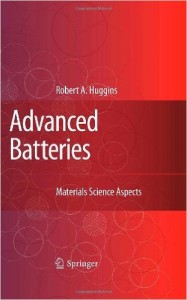Advanced Batteries
Course week(s)
Week 1
Course subject(s)
Introduction
Reference: Huggins R (2008), Advanced Batteries. Springer, ISBN 0387764232.
Storage and conversion are critical components of important energy-related technologies. Advanced Batteries: Materials Science Aspects employs materials science concepts and tools to describe the critical features that control the behavior of advanced electrochemical storage systems. This volume focuses on the basic phenomena that determine the properties of the components, i.e. electrodes and electrolytes, of advanced systems, as well as experimental methods used to study their critical parameters. This unique materials science approach utilizes concepts and methodologies different from those typical in electrochemical texts, offering a fresh, fundamental and tutorial perspective of advanced battery systems. Graduate students, scientists and engineers interested in electrochemical energy storage and conversion will find Advanced Batteries: Materials Science Aspects a valuable reference.


Sustainable Hydrogen and Electrical Energy Storage by TU Delft OpenCourseWare is licensed under a Creative Commons Attribution-NonCommercial-ShareAlike 4.0 International License.
Based on a work at https://ocw.tudelft.nl/courses/sustainable-hydrogen-electrical-energy-storage/.



